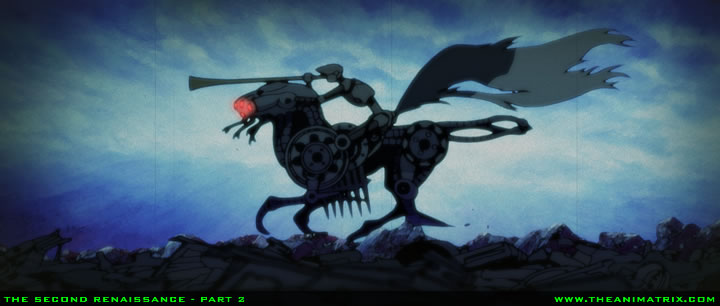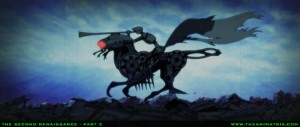
 Archival interview with Mahiro Maeda from the official Matrix website.
Archival interview with Mahiro Maeda from the official Matrix website.
MATRIX: We did our first interview back in November 2000; what has it been like, now that we’ve reached the end of production on SECOND RENAISSANCE?
MAEDA-SAN: When we first spoke I had already decided the direction I wanted to take with SECOND RENAISSANCE. After I received the plot, I had some ideas of my own and put some of my own thoughts into the story, then resubmitted it. When I got feedback on my suggestions, it was clear that they wanted me to stick closer to their story, as SECOND RENAISSANCE is a very important pair of episodes, so I focused on trying to convey the essence of what they wanted to say with the film.
It has been a good two years working on this project now; Larry and Andy trust me so much that we haven’t needed to talk a lot, and have actually had very few conversations directly about the production. The few times we’ve had meetings about the two episodes, I’ve been a little tense, since I have a lot of responsibility for the film. I concentrate on trying to communicate their intentions through the animation, which is very difficult. Mixing together their original idea and my thoughts on the story keeps me in high spirits, but I’m relieved now that they’ve approved most of my ideas. I hope that they really like it, getting a positive response from them would be great.
MATRIX: There are incredible amounts of detail in SECOND RENAISSANCE: Parts 1 & 2, covering a long period of time; what were some of the challenges in making the story work?
MAEDA-SAN: SECOND RENAISSANCE is in many ways like a lecture being given by artificial intelligence. Usually animation has a very traditional story structure, but this film really feels more like a lecture series. Making a story like this exciting, and keeping it from feeling stiff was the first and most difficult problem I faced. As a way around it, I first came up with the idea of using a character through whose eyes we’d watch the story unfold — that way the narrative would become more story-driven. I changed my mind, though, and in the end focused on the idea of exploring the history of the Matrix through the Archives itself. That allowed for a more elaborate way of unfolding the story across the two parts of SECOND RENAISSANCE; in Part One, we see humans treat robots as objects, while in Part Two the relationship between human being and robot switches, as humans are studied by the machines. I enjoyed examining how the two sides changed.
MATRIX: Was there heavy use of computers for these episodes?
MAEDA-SAN: I used 3-D CGI for the robot and instructor to make them more realistic.
MATRIX: Did you find the combined 18-minute running time for SECOND RENAISSANCE at all daunting?
MAEDA-SAN: Originally, Parts One and Two were supposed to be 12 minutes long, six minutes each, but I wanted to make the scenes where the instructor is telling the history of the Matrix more like a Greek legend in scope. We eventually had to expand a few scenes, so they wound up coming in at 18 minutes.
MATRIX: There were some wonderful details in the episodes that weren’t in the script. Could you elaborate on some of the touches you brought to the story?
MAEDA-SAN: I wanted to show the broadness of the society, and how the robots were such a part of the background of life that they were treated as mere objects by human beings. I wanted to emphasize that element in the opening by starting out with a broad establishing shot, and then pulling in close on the robot.
MATRIX: There’s a shot in Part One of SECOND RENAISSANCE where the robot is getting shot, which is taken from a famous photo of a student being executed; how did that develop?
MAEDA-SAN: In exploring the history of the Matrix I wanted to show the audience how badly the robots were being treated. The images we see of the robots being abused are buried in the Archives. There are many examples of mankind’s cruelty in the past, and to imitate an example from real life seemed like a good idea.
MATRIX: How did some of the other references come about?
MAEDA-SAN: For the scene where the robot is crashed by the tank, I referred to the Tiananmen Square incident in China, and what happened between the Chinese army and people. The other scene, where the bulldozer buries the crashed robots, I referred to what happened in Auschwitz.
MATRIX: Was it your intention to find a connection with actual history?
MAEDA-SAN: I felt it would play as ironic that the same things kept repeating throughout history. And remember, the robots didn’t intend to kill humanity. They were trying to build a good relationship with the human race, but what happens is that humans take revenge on the robots. So in the world of The Matrix, human beings are kept alive by the robots, as the robots pull energy out of them. It’s the opposite of Utopia for the humans. I wanted audiences to enjoy the visually ironic scenes as an example of how everything was complexly intertwined. It’s possible some audiences might get frustrated by watching those cruel scenes, but I hoped it would be a good opportunity for viewers to reflect and consider what being normal means, and whether this behavior is normal or not.
MATRIX: Who is the villain?
MAEDA-SAN: In this world there are no villains. Just like in the real world, only different positions in society or differences in value or ideas. Those differences are what lead to conflict in life. When audiences watch both segments of SECOND RENAISSANCE, I want them to think about how differently they would look at life if they just considered it from the other side of society.
MATRIX: The two parts of SECOND RENAISSANCE come first chronologically among the short films. Is there any added burden, knowing your sequences are going to be at the beginning of the episodes?
MAEDA-SAN: Of course. The SECOND RENAISSANCE episode is the first episode the audience will see after the motion picture. My main concern was to bring to the stories the originality of the original motion picture, and retain the feel of the world of the Matrix. I wanted these episodes to feel like a continuation of the movies.
MATRIX: Is it a liberating feeling, now that the episodes are done?
MAEDA-SAN: I feel relieved, of course… but there are some parts that I regret not doing. I’m happy with most of it, and am especially satisfied with the final image of the instructor. Thanks go to my staff, who worked very hard for me so the image of the instructor would be realized as I envisioned it. I want the audience to enjoy the images and I am looking forward to seeing the film with the final soundtrack.
MATRIX: Will you be working with Don Davis on the music and the sound effects team from THE MATRIX RELOADED?
MAEDA-SAN: Yes, and I’m looking forward to working with Don Davis, as well as on the sound effects. I’m interested in Don’s ideas and how he plans to marry the sound effects to the many short sequences throughout the episodes, which might be difficult. I’m looking forward to seeing the end result.
MATRIX: How would you describe SECOND RENAISSANCE to someone who didn’t know what the series was about?
MAEDA-SAN: I wanted to make this film as beautiful as a story from ancient Greek myth, and explore what it means to be human, as well as not human, and how the ideas are related to one another. In Greek myths there are moments where the best side of human nature is explored, and others where the protagonists are shown as very cruel. I wanted bring the same atmosphere to these episodes.
MATRIX: SECOND RENAISSANCE involves a robot butler that was designed by Geof Darrow; did you have a good time working with Geof’s designs?
MAEDA-SAN: When I read the story I came up with an image of the robot whose trial really instigates the shift of power between humans and machines, but then I found out that the character had been designed already by Geof. I saw his design and thought it was beautiful — there were so many detailed lines in his conceptualization of the butler that I was concerned how I would get it to work in animation. I had to eliminate some of the linework, but I hope that Geof likes how it turned out.
MATRIX: There were also Fetus Harvesters to animate; what was it like representing versions of those creatures?
MAEDA-SAN: I took a more primitive approach with the Harvester than what was shown in the original MATRIX. I figured the Harvester we saw in the movie was more advanced than the one we encounter here, so I redesigned the model a little bit. Also, the robots in these episodes are more focused on hunting human beings, so their way of attacking was more aggressive.
MATRIX: With plans to distribute the episodes over the Internet as well as on DVD, are you excited about people being able to download SECOND RENAISSANCE onto their computers?
MAEDA-SAN: It’ll be ironic to see them on a PC. It’s very interesting to think of people being able to download and watch these episodes wherever they are, whenever they want to.
MATRIX: Is anxiety going to increase as the episodes get closer to release; are you still thinking about it a lot?
MAEDA-SAN: I’ve already started work on my next production, so in a month and a half, while waiting for their release, I’ll be focused on the next film. Of course I look forward to the release of THE MATRIX RELOADED, and look forward to seeing the final version of THE SECOND RENAISSANCE.
MATRIX: Thank you, Maeda-San.
Interview by REDPILL
Translated by Isako Shibata
July 2002

Be the first to comment